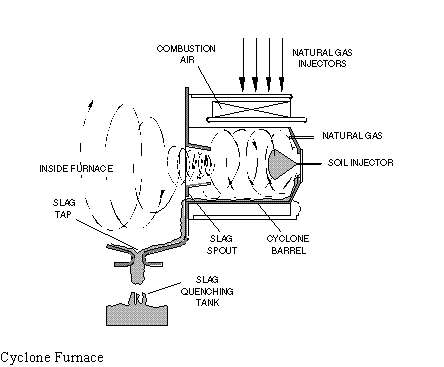
(Cyclone Furnace)
The Babcock & Wilcox Co. (Babcock & Wilcox) cyclone furnace is designed to combust coal with high inorganic content (high-ash). Through cofiring, the cyclone furnace can also accommodate highly contaminated wastes containing heavy metals and organics in soil or sludge. High heat-release rates of 45,000 British thermal units (Btu) per cubic foot of coal and high turbulence in cyclones ensures the high temperatures required for melting the high-ash fuels and combusting the organics. The inert ash exits the cyclone furnace as a vitrified slag.
The pilot-scale cyclone furnace, shown in the figure below, is a water cooled, scaled-down version of a commercial coal-fired cyclone with a restricted exit (throat). The furnace geometry is a horizontal cylinder (barrel).

Natural gas and preheated combustion air are heated to 820 °F and enter tangentially into the cyclone burner. For dry soil processing, the soil matrix and natural gas enter tangentially along the cyclone furnace barrel. For wet soil processing, an atomizer uses compressed air to spray the soil slurry directly into the furnace. The soil or sludge and inorganics are captured and melted, and organics are destroyed in the gas phase or in the molten slag layer. This slag layer is formed and retained on the furnace barrel wall by centrifugal action.
The soil melts, exits the cyclone furnace from the tap at the cyclone throat, and drops into a water-filled slag tank where it solidifies. A small quantity of soil also exits as fly ash with the flue gas from the furnace and is collected in a baghouse. In principle, this fly ash can be recycled to the furnace to increase metal capture and to minimize the volume of the potentially hazardous waste stream.
The energy requirements for vitrification are 15,000 Btu per pound of soil treated. The cyclone furnace can be operated with gas, oil, or coal as the supplemental fuel. If the waste is high in organic content, it may also supply a significant portion of the required fuel heat input.
Particulates are captured by a baghouse. To maximize the capture of particulate metals, a heat exchanger is used to cool the stack gases to approximately 200 °F before they enter the baghouse.
The cyclone furnace can treat highly contaminated hazardous wastes, sludges, and soils that contain heavy metals and organic constituents. The wastes may be solid, a soil slurry (wet soil), or liquids. To be treated in the cyclone furnace, the ash or solid matrix must melt (with or without additives) and flow at cyclone furnace temperatures (2,400 to 3,000 °F). Because the furnace captures heavy metals in the slag and renders them nonleachable, it is particularly suited to soils that contain lower-volatility radionuclides such as strontium and transuranics.
Based on results from the Emerging Technology Program, the cyclone furnace technology was accepted into the SITE Demonstration Program in August 1991. A demonstration occurred in November 1991 at the developer's facility in Alliance, Ohio. The process was demonstrated using an EPA-supplied, wet synthetic soil matrix (SSM) spiked with heavy metals (lead, cadmium, and chromium), organics (anthracene and dimethylphthalate), and simulated radionuclides (bismuth, strontium, and zirconium). Results from the demonstrations have been published in the Applications Analysis Report (EPA/520/AR-92/017) and Technology Evaluation Report, Volumes 1 and 2 (EPA/504/R-92/017A and EPA/540/R-92/017B); these documents are available from EPA.
Vitrified slag leachabilities for the heavy metals met EPA toxicity characteristic leaching procedure (TCLP) limits. TCLP leachabilities were 0.29 milligram per liter (mg/L) for lead, 0.12 mg/L for cadmium, and 0.30 mg/L for chromium. Almost 95 percent of the noncombustible SSM was incorporated into the slag. Greater than 75 percent of the chromium, 88 percent of the strontium, and 97 percent of the zirconium were captured in the slag. Dry weight volume was reduced 28 percent. Destruction and removal efficiencies for anthracene and dimethylphthalate were greater than 99.997 percent and 99.998 percent, respectively. Stack particulates were 0.001 grain per dry standard cubic foot (gr/dscf) at 7 percent oxygen, which was below the Resource Conservation Recovery Act limit of 0.08 gr/dscf effective until May 1993. Carbon monoxide and total hydrocarbons in the flue gas were 6.0 parts per million (ppm) and 8.3 ppm, respectively.
An independent cost analysis was performed as part of the SITE demonstration. The cost to remediate 20,000 tons of contaminated soil using a 3.3-ton-per-hour unit was estimated at $465 per ton if the unit is on line 80 percent of the time, and $529 per ton if the unit is on line 60 percent of the time.
EPA PROJECT MANAGER:
Laurel Staley
U.S. EPA
National Risk Management Research Laboratory
26 West Martin Luther King Drive
Cincinnati, OH 45268
513-569-7863
Fax: 513-569-7105
TECHNOLOGY DEVELOPER CONTACT:
Evans Reynolds
Babcock & Wilcox Co.
2220 Langhorne Road
Lynchburg, VA 24506-0598
804-522-6000
Fax: 804-948-4846